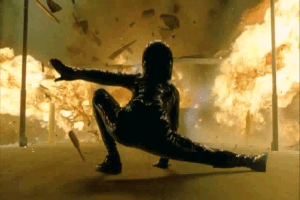

Facing reality can be invigorating.
Late last Thursday evening, a friend and I watched The Matrix. Larry and Andy Wachowski’s film masterpiece, it was my fourth viewing. Watching it yet again was as epic as my first viewing back in 1999.
If you are one of the seven adults in the world who haven’t seen the movie, this is a spoiler-alert. I won’t go into much plot detail here, but know The Matrix is best experienced cold-turkey. Maybe set this post aside until you’ve seen it.
As I cued up the DVD, I glanced at the Netflix disc cover and its brief description of the movie. The memories came back when I noticed the release date was just prior to my personal “systems mini-enlightenment.” For those of you who haven’t read my book, Work the System, one of the key premises is that it’s possible to experience a sudden and permanent change in how one perceives the world. The Matrix carries the same message.
So before we began the movie I off-handedly opened a nearby copy of Work to the Chapter entitled Getting It, and read the Matrix’s quote that begins the chapter. It’s Morpheus speaking, the sagacious Yoda-like character played by Laurence Fishburne.
For those of you who have not seen the movie (and have ignored the above spoiler alert), know that the movie’s message is a mind-bender extraordinaire. The acting and production are terrific, contributing to the electrifying mind-jolt that makes it the best sci-fi picture of the past forty years. If you watch it with a clear head, paying close attention to subtleties… it damn well makes you think, and rethink. The implausible plot notwithstanding, the movie opens the door for viewers to question their up-until-now assumptions of reality.
Near the beginning, Neo (Keanu Reeves), the protagonist, must make a decision. He can choose to see the ugly truth of his world and learn to deal with that reality, or he can decide to continue negotiating his life in a somnambulant stupor, floating on the safe and convenient assumption that things are exactly as they appear to be. He makes the proper choice (the “red pill”) knowing full-well that swallowing it could reveal a painful and irreversible hard truth. Then, in gut-churning contortion, that’s exactly what happens as he learns the deeper reality of his world that is, well…let’s just say…different from what he thought it was. For those of you who have seen the movie, you understand the not-so-subtle message that we as individuals could very well be living delusional lives; missing major truths that, if we could just see them, would give us the power to break free; to get what we want in our lives. (After all, if we deal with the machinery of life as it actually is, we’re more apt to get what we want in our individual lives.) This is the primary message of the movie (and yes, my book Work the System): By learning the down-and-dirty truth of how the mechanical world really operates, however punishing that truth might be, one will find dramatically increased control over one’s life.
Knowledge is power.
Another salient point: Making life-changes due to a dramatically new vision often includes walking away from something and/or someone, never to return. The new path is too disparate from the original path.
So we watched the movie, mesmerized. After it ended in Friday morning’s wee hours, my date left for home and I, totally wired, read Work’s Chapter 7, the one that begins with Morpheus’ quote. While reading, it occurred to me that back in 1999 as I sat alone in a Saturday matinee watching The Matrix for the first time, the movie must have been, at least on a subliminal level, part of the catalyst for the systems awakening I would experience a short time later. Although I was mentally and physically ripe for the insight, it may have been this shoot-em-up Hollywood movie that pushed me over the edge, to go a layer deeper, to finally understand the world is not a confused mass of sights, sounds and events, but a logical collection of linear systems, systems that can be adjusted to create the life-results I desired.
That was fifteen years ago. The new vision was so vastly different from my previous life-stance, it took me five years of stumbling and experimentation to straighten out my world and to perfect what I call the work the System Method. If I knew then what I know now, I could have repaired my contorted life in a single year.
In the beginning, Neo felt “something is not right with the world.” He carried on anyway, as we all do. So, if your life is not clicking along efficiently, give it a shot: File away pre-conceived notions of how you think your world operates and consider a new, mechanical vantage point. Choose the red pill and see what happens next.
As I began writing Work the System in early 2006, the Chapter, Getting It, was the first one I completed. Describing a “room full of boxes,” it’s one of my two favorite chapters, a metaphorical description of the system improvement process. The first part of the chapter follows.
Work the System:
The Simple Mechanics of Making More and Working Less
Chapter 7, partial
A Room Full Of Boxes
“I’m trying to free your mind but I can only show you the door. You’re the one who has to walk through it.”
—Morpheus (Laurence Fishburne) from the movie The Matrix
(Warner Bros. Pictures, 1999)
First you work your systems, then your systems do the work. Imagine the following metaphorical scenario.
Recently it became clear that one of the managers in the company where you work had neglected his department. It showed in the lack of output and the general chaos.
Yesterday, he was fired.
You feel bad the department manager lost his job, but you understand why it happened. This sometimes occurs, and when it does you usually see it firsthand. You are a troubleshooter for your organization, and your role is to get the apples back on the cart when they fall off.
You make your way to the department, which occupies a single room in your building.
You walk through a door into a large, dimly-lit room. It’s one you’ve been in before. The room is empty except for several dozen wooden boxes varying in size. The containers, each with a hinged wooden lid, are scattered around the room. You begin by replacing the burnt-out light bulbs and then pushing the boxes around so they are in order, taking time to organize them so you can perform your work in a logical way.
You’ve brought your toolbox, and of course you have written technical instructions if there are questions. The repair and maintenance procedures are understandable and well thought-out. You know this because you are the one who supervised their creation.
Because of the previous neglect of the contents of these boxes, you knew before you came here that completing this job would require a long day. You hunker down and get to work.
You open the lid of the first box and find a mechanical apparatus within. It’s made up of gears, wires, and levers, and because you are a technician trained in understanding the construction of such devices, what you see makes sense. It is clear to you what this mechanism does and how it is put together. Peering deeper into the box to examine the intricacies within, it is apparent that adjustments are necessary. You make them. In the course of your work you notice an obsolete component. You replace it with an updated version (you always carry spares). This revision will make the device more efficient and reliable.
Then you oil the moving parts and finish by cleaning up the mechanism, wiping it off.
Finally, you thoroughly test it to make sure it’s working perfectly. It is.
On the inside of the box lid you write the date and your initials, along with a brief summary of what you did so that when the new department manager shows up for the first day of work, he or she will know what you’ve done, and when.
You close the lid and move on to the next box. You repeat the process. One by one you move through all the boxes, making each of the unique mechanisms within them perfect, closing the lids afterward.
It indeed takes the entire day to complete your work, but the time went quickly as you spent your hours in a creative, constructive flow space.
You’ve finished, and you stand in the doorway and take a last look around the room. The boxes are in neat rows, their lids closed, and you are confident the devices within the boxes are working perfectly. You know the department’s output will be very good now because each of its mechanisms is working flawlessly. How could it be otherwise? You also know the new department manager will be system-improvement oriented, watching over the details of the department, not allowing it to fall back into disarray. There will be routine maintenance. As you turn off the lights and walk out the door, you are intensely satisfied with your work and with yourself.
There it is—the systems mindset approach in which one sees life as a collection of individual systems (or call them processes or mechanisms or machines) that are to be, one by one, isolated and then made perfect. And once perfected, they are routinely coddled for maintenance and upgrading.
Here’s the no-brainer that eludes most people: in the course of a day and in the course of a life, each movement we make is a single step in a linear sequence of steps intended to accomplish one or another goal. Each thing we do is a component of a system, a system that has a purpose.
Photo: Trinity makes her entrance. Opening scene from the 2003 movie, The Matrix: Reloaded (and 2nd episode of the Matrix movietrilogy).
